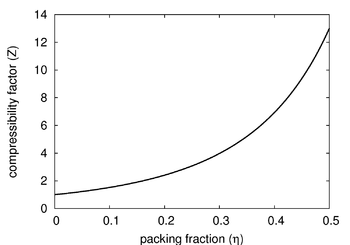Carnahan-Starling equation of state: Difference between revisions
Carl McBride (talk | contribs) (Added a Kolafa correction section) |
|||
| Line 73: | Line 73: | ||
The reason for this seems to be a slight mystery (see discussion in Ref. <ref>[http://dx.doi.org/10.1021/j100356a008 Yuhua Song, E. A. Mason, and Richard M. Stratt "Why does the Carnahan-Starling equation work so well?", Journal of Physical Chemistry '''93''' pp. 6916-6919 (1989)]</ref> ). | The reason for this seems to be a slight mystery (see discussion in Ref. <ref>[http://dx.doi.org/10.1021/j100356a008 Yuhua Song, E. A. Mason, and Richard M. Stratt "Why does the Carnahan-Starling equation work so well?", Journal of Physical Chemistry '''93''' pp. 6916-6919 (1989)]</ref> ). | ||
== Kolafa correction == | |||
Jiri Kolafa produced a slight correction to the C-S EOS which results in improved accuracy <ref>[http://dx.doi.org/10.1063/1.4870524 Miguel Robles, Mariano López de Haro and Andrés Santos "Note: Equation of state and the freezing point in the hard-sphere model", Journal of Chemical Physics '''140''' 136101 (2014)]</ref>: | |||
: <math> | |||
Z = \frac{ 1 + \eta + \eta^2 - \frac{2}{3}(1+\eta) \eta^3 }{(1-\eta)^3 }. | |||
</math> | |||
== See also == | == See also == | ||
Revision as of 12:16, 8 April 2014

The Carnahan-Starling equation of state is an approximate (but quite good) equation of state for the fluid phase of the hard sphere model in three dimensions. It is given by (Ref [1] Eqn. 10).
where:
- is the compressibility factor
- is the pressure
- is the volume
- is the number of particles
- is the Boltzmann constant
- is the absolute temperature
- is the packing fraction:
- is the hard sphere diameter.
Virial expansion
It is interesting to compare the virial coefficients of the Carnahan-Starling equation of state (Eq. 7 of [1]) with the hard sphere virial coefficients in three dimensions (exact up to , and those of Clisby and McCoy [2]):
| Clisby and McCoy | ||
| 2 | 4 | 4 |
| 3 | 10 | 10 |
| 4 | 18.3647684 | 18 |
| 5 | 28.224512 | 28 |
| 6 | 39.8151475 | 40 |
| 7 | 53.3444198 | 54 |
| 8 | 68.5375488 | 70 |
| 9 | 85.8128384 | 88 |
| 10 | 105.775104 | 108 |
Thermodynamic expressions
From the Carnahan-Starling equation for the fluid phase the following thermodynamic expressions can be derived (Ref [3] Eqs. 2.6, 2.7 and 2.8)
Pressure (compressibility):
Configurational chemical potential:
Isothermal compressibility:
where is the packing fraction.
Configurational Helmholtz energy function:
The 'Percus-Yevick' derivation
It is interesting to note (Ref [4] Eq. 6) that one can arrive at the Carnahan-Starling equation of state by adding two thirds of the exact solution of the Percus Yevick integral equation for hard spheres via the compressibility route, to one third via the pressure route, i.e.
The reason for this seems to be a slight mystery (see discussion in Ref. [5] ).
Kolafa correction
Jiri Kolafa produced a slight correction to the C-S EOS which results in improved accuracy [6]:
See also
References
- ↑ 1.0 1.1 N. F. Carnahan and K. E. Starling,"Equation of State for Nonattracting Rigid Spheres" Journal of Chemical Physics 51 pp. 635-636 (1969)
- ↑ Nathan Clisby and Barry M. McCoy "Ninth and Tenth Order Virial Coefficients for Hard Spheres in D Dimensions", Journal of Statistical Physics 122 pp. 15-57 (2006)
- ↑ Lloyd L. Lee "An accurate integral equation theory for hard spheres: Role of the zero-separation theorems in the closure relation", Journal of Chemical Physics 103 pp. 9388-9396 (1995)
- ↑ G. A. Mansoori, N. F. Carnahan, K. E. Starling, and T. W. Leland, Jr. "Equilibrium Thermodynamic Properties of the Mixture of Hard Spheres", Journal of Chemical Physics 54 pp. 1523-1525 (1971)
- ↑ Yuhua Song, E. A. Mason, and Richard M. Stratt "Why does the Carnahan-Starling equation work so well?", Journal of Physical Chemistry 93 pp. 6916-6919 (1989)
- ↑ Miguel Robles, Mariano López de Haro and Andrés Santos "Note: Equation of state and the freezing point in the hard-sphere model", Journal of Chemical Physics 140 136101 (2014)

















![{\displaystyle Z={\frac {pV}{Nk_{B}T}}={\frac {2}{3}}\left[{\frac {(1+\eta +\eta ^{2})}{(1-\eta )^{3}}}\right]+{\frac {1}{3}}\left[{\frac {(1+2\eta +3\eta ^{2})}{(1-\eta )^{2}}}\right]={\frac {1+\eta +\eta ^{2}-\eta ^{3}}{(1-\eta )^{3}}}}](https://wikimedia.org/api/rest_v1/media/math/render/svg/be142b5b421225e5516478eb7d6d109e06d8dd61)
